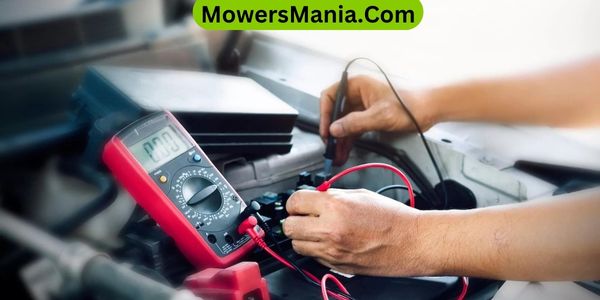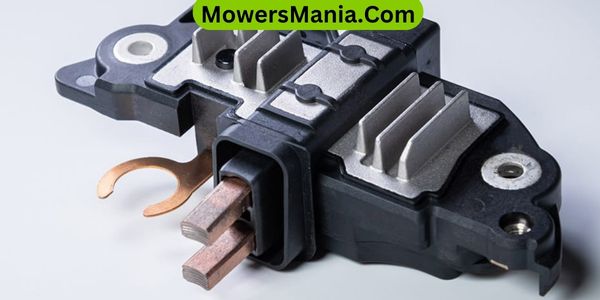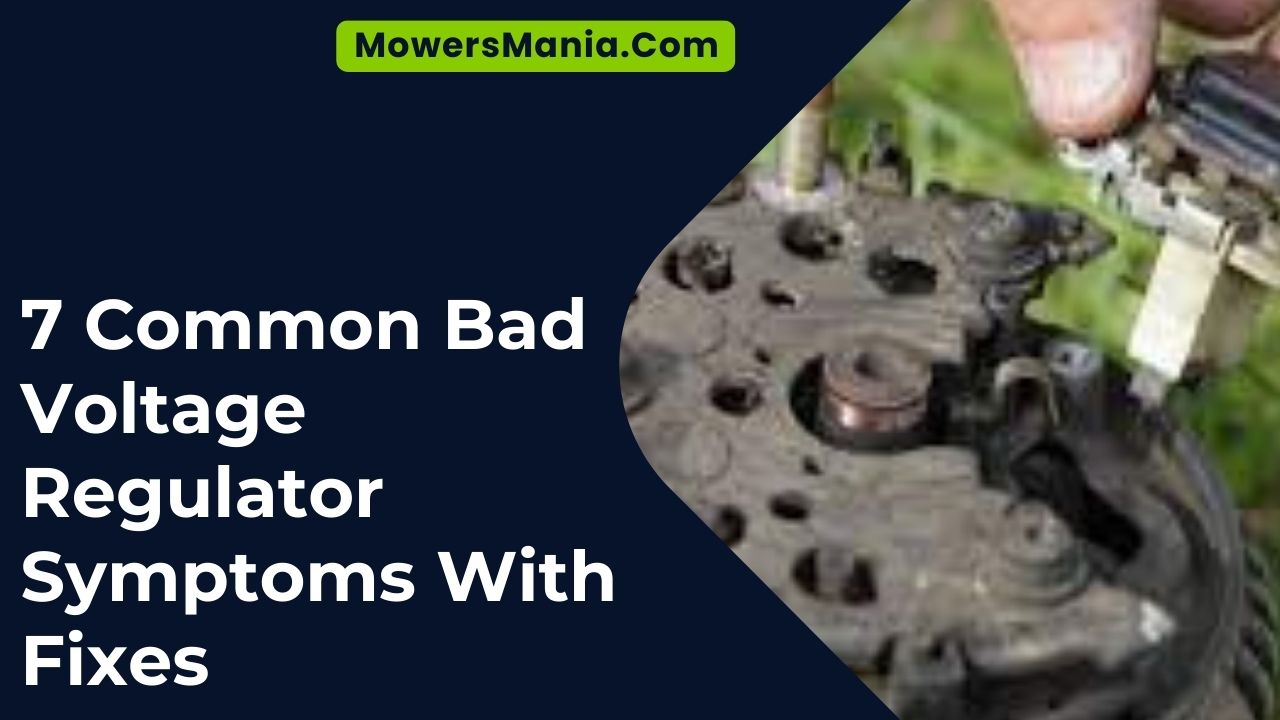Have you ever wondered if your vehicle’s electrical issues could be caused by a bad voltage regulator?
In this guide, we’ll explore seven common symptoms of a faulty voltage regulator and provide you with practical fixes to address each issue.

From flickering lights to engine stalling, understanding these warning signs can help you diagnose and resolve potential voltage regulator problems.
Whether it’s a dead battery, overcharging, or undercharging, we’ll walk you through the steps to rectify the situation.
By the end, you’ll be equipped with the knowledge to tackle voltage regulator replacement and keep your vehicle’s electrical system running smoothly.
Flickering Lights
If you notice flickering lights in your vehicle, it could be a sign of a bad voltage regulator. Flickering lights are one of the most common symptoms of a failing voltage regulator.
When the voltage regulator malfunctions, it can cause erratic power to be supplied to the lights, resulting in flickering or pulsating lights. This can be particularly noticeable when idling or at low speeds when the alternator isn’t producing its maximum output.
To fix the issue, you should first have the voltage regulator and the entire charging system checked by a qualified mechanic.
They’ll be able to diagnose whether the flickering lights are indeed caused by a faulty voltage regulator or if there’s another underlying issue.
If the voltage regulator is determined to be the culprit, it will need to be replaced. This is a relatively straightforward fix for a professional and should resolve the problem of flickering lights in your vehicle.
Ignoring this issue can lead to further electrical problems in your vehicle, so it’s important to address the flickering lights as soon as possible.
Dead Battery
Experiencing flickering lights in your vehicle can lead to a dead battery, indicating a potential issue with the voltage regulator. A dead battery is a common symptom of a faulty voltage regulator, and it can cause various issues for your vehicle.
Here are some key points to consider:
- Difficulty Starting: A dead battery will make it challenging to start your vehicle, and you may hear clicking sounds when you try to turn the ignition.
- Electrical Failures: The dead battery can lead to the failure of electrical components such as power windows, radio, and dashboard lights.
- Stalling: In some cases, a dead battery caused by a faulty voltage regulator can result in your vehicle stalling while driving.
- Charging System Warning Light: If your vehicle’s charging system warning light is illuminated on the dashboard, it could indicate a problem with the voltage regulator, which may lead to a dead battery.
Addressing a dead battery promptly is crucial to prevent further damage to your vehicle and ensure your safety on the road. If you notice these symptoms, it’s advisable to have your voltage regulator and battery inspected by a professional.
Overcharging
You may frequently notice your vehicle’s battery overcharging, indicating a potential issue with the voltage regulator. Overcharging occurs when the voltage regulator sends too high of a voltage to the battery, leading to excessive gassing and water loss.
This can ultimately damage the battery and other electrical components in your vehicle. To help you understand the signs and solutions for overcharging, refer to the table below.
| Symptoms of Overcharging | Fixes for Overcharging |
|---|---|
| – Bulging battery | – Check the alternator |
| – Flickering or dimming lights | – Inspect the voltage regulator |
| – Strange battery smell | – Test the battery |
| – Corroded battery terminals | – Replace the voltage regulator if needed |
If you’re experiencing any of these symptoms, it’s crucial to address the issue promptly to prevent further damage to your vehicle’s electrical system.
Ignoring overcharging can lead to costly repairs and potential safety hazards. By taking the necessary steps to diagnose and fix the overcharging problem, you can ensure the longevity and reliability of your vehicle’s electrical components.
Undercharging

Addressing undercharging is essential to maintaining the health of your vehicle’s electrical system. When your vehicle’s voltage regulator fails to maintain the proper charge, it can lead to various issues that affect the overall performance of your car.
Here are some common symptoms of undercharging to watch out for:
- Dimming or flickering lights: Undercharging can cause your headlights and interior lights to dim or flicker, indicating a lack of sufficient electrical power.
- Slow power windows: If your power windows are moving slower than usual, it could be a sign of undercharging as the regulator struggles to provide adequate power to the windows’ motors.
- Difficulty starting the engine: Undercharging can lead to insufficient power for the starter motor, making it harder for the engine to start.
- Unresponsive electrical accessories: Your vehicle’s electrical accessories, such as the radio or air conditioning, may become unresponsive or function intermittently due to undercharging.
If you notice any of these symptoms, it’s crucial to address the undercharging issue promptly to prevent further damage to your vehicle’s electrical components.
Engine Stalling
To prevent engine stalling, promptly diagnose and address any voltage regulator issues affecting your vehicle’s electrical system.
Engine stalling is a common symptom of a faulty voltage regulator. When the voltage regulator fails to maintain a steady voltage, it can lead to erratic electrical power supply to crucial engine components, causing the engine to stall unexpectedly.
If you notice your engine cutting out or stumbling at irregular intervals, especially when idling or driving at low speeds, it could be a sign of voltage regulator problems.
To address this issue, start by checking the voltage output from the alternator to ensure it’s within the manufacturer’s specifications. Additionally, inspect the wiring and connections for any signs of damage, corrosion, or poor contact.
If the voltage output is erratic or outside the specified range, or if there are issues with the wiring or connections, consider replacing the voltage regulator or repairing any damaged components. Promptly resolving voltage regulator issues can help prevent engine stalling and ensure the proper functioning of your vehicle.
Electrical System Malfunctions
If experiencing electrical system malfunctions, closely monitor the performance of your vehicle’s components and wiring for signs of voltage irregularities.
Inconsistent voltage supply can lead to various issues within your vehicle’s electrical system, causing malfunctions that affect critical functions.
Here are some signs to watch out for:
- Flickering lights: If you notice your headlights, dashboard lights, or interior lights flickering, it could indicate voltage irregularities.
- Electrical component failure: Keep an eye out for the failure of electrical components such as power windows, door locks, or the radio, as these can be indicative of voltage regulation problems.
- Dead battery: A malfunctioning voltage regulator can lead to overcharging or undercharging the battery, leading to premature failure.
- Erratic engine performance: Voltage irregularities can impact the engine control module, causing erratic idling, stalling, or difficulties starting the engine.
Monitoring these signs can help you detect and address voltage regulator issues before they lead to more severe electrical system malfunctions.
Voltage Regulator Replacement

First, you’ll need to gather the necessary tools and replacement parts for the voltage regulator replacement.
You’ll require a wrench or socket set, screwdrivers, and pliers to remove the old voltage regulator and install the new one. Make sure to have the replacement voltage regulator specific to your vehicle’s make and model.
Begin by disconnecting the negative terminal of the vehicle’s battery to ensure safety during the replacement process. Then, locate the voltage regulator, which is usually found on the firewall, fender, or the engine’s rear.
Once located, carefully disconnect the electrical connectors and remove the mounting bolts holding the old voltage regulator in place.
Next, install the new voltage regulator by securing it with the mounting bolts and reconnecting the electrical connectors. Double-check that all connections are secure and the regulator is properly mounted. After ensuring everything is in place, reattach the negative terminal of the battery.
Frequently Asked Questions [FAQs]
How Can I Test My Voltage Regulator to See if It’s Functioning Properly?
To test your voltage regulator, start by checking the battery voltage while the engine is running. Next, use a multimeter to measure the voltage at the battery terminals. If the voltage is within the acceptable range, your regulator is functioning properly.
Can a Faulty Voltage Regulator Cause Damage to Other Electrical Components in My Vehicle?
Yes, a faulty voltage regulator can cause damage to other electrical components in your vehicle. It can lead to overcharging or undercharging the battery, which can harm the alternator, wiring, and other sensitive electronics.
Are There Any Warning Signs or Symptoms That Indicate a Voltage Regulator Is About to Fail?
If your vehicle’s voltage regulator is about to fail, warning signs may include dimming or flickering lights, the battery light appearing on the dashboard, or erratic engine performance. Get it checked promptly.
What Are Some Common Reasons for Voltage Regulator Failure?
If your voltage regulator fails, it’s often due to overheating, overcharging, or vibration. These can cause internal components to wear out and fail. Regular maintenance and monitoring can help prevent these issues.
Is It Possible for a Voltage Regulator to Cause Intermittent Electrical Issues, Rather Than Constant Problems?
Yes, a voltage regulator can cause intermittent electrical issues. It may result in sporadic power fluctuations or device malfunctions. You should monitor your electrical system for any irregularities and have the voltage regulator checked by a professional.
Conclusion
So, if you’re experiencing any of these symptoms, it’s important to address them as soon as possible to avoid further damage to your vehicle.
Whether it’s flickering lights, a dead battery, or engine stalling, the voltage regulator is a crucial component that needs to be functioning properly.
By diagnosing and fixing these issues, you can ensure that your vehicle’s electrical system runs smoothly and efficiently.
Don’t wait until it’s too late – take action now to avoid costly repairs in the future.



